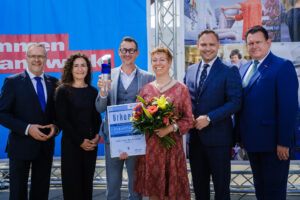Zugleich aber macht ein IT- und Chip-Cluster allein noch keinen erfolgreichen Standort aus. Dazu braucht es weitere Unternehmen, neben Konzernen auch mittelständische Firmen – sowie Unternehmen aus allen Branchen. Die Vielfalt letztlich macht den Mix und Erfolg aus und stiftet zugleich Sicherheit.
Das erleben auch Anlegerinnen und Anleger beim Blick auf ihr privates Anlage-Portfolio. Wer nur auf Lebensversicherungen, Tagesgeld oder Sparbriefe setzt, geht zwar wenig Risiko ein, verzichtet aber auch auf interessante Renditen. Wer dagegen ausschließlich auf Kryptowährungen setzt oder mit äußerst riskanten Aktien aus Nischenmärkten hantiert, nimmt ein viel zu hohes Risiko in Kauf.
Sachwerte bieten Schutz vor allem in so stürmischen Zeiten
Entscheidende Bedeutung kommt daher der richtigen Mischung im Portfolio zu: Und da spielen Sachwerte eine wichtige Rolle als wertsichernder Bestandteil mit zugleich einer möglichst guter Performance-Aussicht. In einer Zeit zunehmender wirtschaftlicher Unsicherheiten und volatiler Finanzmärkte suchen Anleger nach Möglichkeiten, ihre Vermögenswerte zu schützen und zu diversifizieren.
Sachanlagen umfassen eine Vielzahl von Investitionsmöglichkeiten, darunter Immobilien, Edelmetalle, Kunstwerke, Infrastrukturprojekte und natürliche Ressourcen. Im Gegensatz zu rein finanziellen Anlagen wie Aktien oder Anleihen sind Sachanlagen physisch vorhanden, was sie widerstandsfähiger gegenüber Marktschwankungen und Inflationsrisiken macht. Diese physische Präsenz verleiht ihnen letztlich den sogenannten intrinsischen Wert, der unabhängig von der kurzfristigen Marktstimmung besteht.
Ein wesentlicher Vorteil von Sachanlagen liegt in ihrer Funktion als Inflationsschutz: Während die Kaufkraft von Währungen im Laufe der Zeit abnehmen kann, neigen Sachwerte dazu, ihren Wert zu behalten oder sogar zu steigern. Darüber hinaus bieten Sachanlagen eine Diversifizierung, die entscheidend für die Risikominimierung in einem Anlage-Portfolio ist. Durch die Investition in verschiedene Anlageklassen – etwa eine Kombination aus Aktien, Anleihen und Sachanlagen – kann das Risiko eines Portfolioverlustes erheblich reduziert werden. Diese Diversifikation sorgt dafür, dass Verluste in einer Anlageklasse durch Gewinne in einer anderen ausgeglichen werden können. Sachanlagen spielen dabei eine besondere Rolle, da ihre Wertentwicklung oft weniger stark mit traditionellen Finanzmärkten korrespondiert. Selbst in Phasen, in denen Aktien und Anleihen schwächeln, können sie stabile Erträge liefern.
Seit jeher setzen viele bei Sachwerten auf Immobilien – etwa die vermietete Eigentumswohnung – oder auf Gold. Doch die Immobilienblase ist zuletzt geplatzt, viele Finanzierungen sind gekippt. Zudem binden Immobilien viel Kapital. Gold dagegen ist, ob als Barren oder Münze, zu deutlich kleineren und damit bezahlbareren Einheiten zu erwerben. In den vergangenen Jahren haben Anlegerinnen und Anleger mit dem glänzenden Edelmetall gute Gewinne markiert. Der Preis für die Feinunze hat zuletzt ein neues Allzeithoch erreicht. Da stellt sich die Frage: Kann das so weitergehen? Hinzu kommt, dass Gold in US-Dollar bewertet wird. Käufer aus dem Euroraum unterliegen damit immer einem Wechselkursrisiko.
Osmium macht Gold und Silber als Sachanlage zunehmend den Rang streitig
Gold allein sollte daher auch nicht die Sachanlagen-Sparte im Depot dominieren. Vielmehr ist es ratsam, den Blick zu erweitern und die „Rising Stars“ am Edelmetallmarkt in den Blick zu nehmen. Hier führt inzwischen kein Weg am bläulich schimmerndem Osmium vorbei. Das achte und damit letzte Edelmetall wurde erst vor rund 200 Jahren entdeckt. Doch erst seit vor etwa einer Dekade die Möglichkeit der Kristallisation entdeckt wurde, startete Osmium als Werkstoff für die Schmuckindustrie sowie als Sachanlage erst spät so richtig durch.
Mit nur einem Kubikmeter förderbarem Osmium ist kein Edelmetall seltener als Osmium. Und kein anderes Metall droht so schnell auszugehen wie dieses. Aufgrund der begrenzten und bereits ausgeschöpften natürlichen Vorräte aus vertrauenswürdigen Quellen endet die Kristallisation von Osmium bereits 2026, wonach dann wahrscheinlich schon die Stunde des Zweitmarkts in diesem Kontext geschlagen haben wird, was bestimmt eine gute Kunde für alle Investoren sein wird, die sich rechtzeitig mit dem Edelmetall eingedeckt haben.
Anders als etwa Gold ist Osmium absolut fälschungssicher: Die Kristallstruktur von Osmium wird bis herunter in den Nanometerbereich gescannt. Damit ist es unmöglich, die Struktur nachzubauen. Die Sicherheit übersteigt die eines Fingerabdrucks bereits auf nur einem Quadratmillimeter um das Zehntausendfache. Alle Daten zu zertifizierten Osmium-Stücken, zu Eigentümern und zu Osmium-Bewegungen sowie Zoll und Besitzwechsel werden außerdem in der hochgesicherten Osmium-Datenbank konform zu den Richtlinien der Datenschutzgrundverordnung gespeichert und das besondere Edelmetall wird gemäß der US-Rulings international in den Verkehr eingebracht.
Gastbeitrag von Ingo Wolf über die Bedeutung von Edelmetallen für den Anlageerfolg. Ingo Wolf ist Direktor Analytik und Materialwissenschaften des Osmium-Instituts mit Sitz in Murnau.








